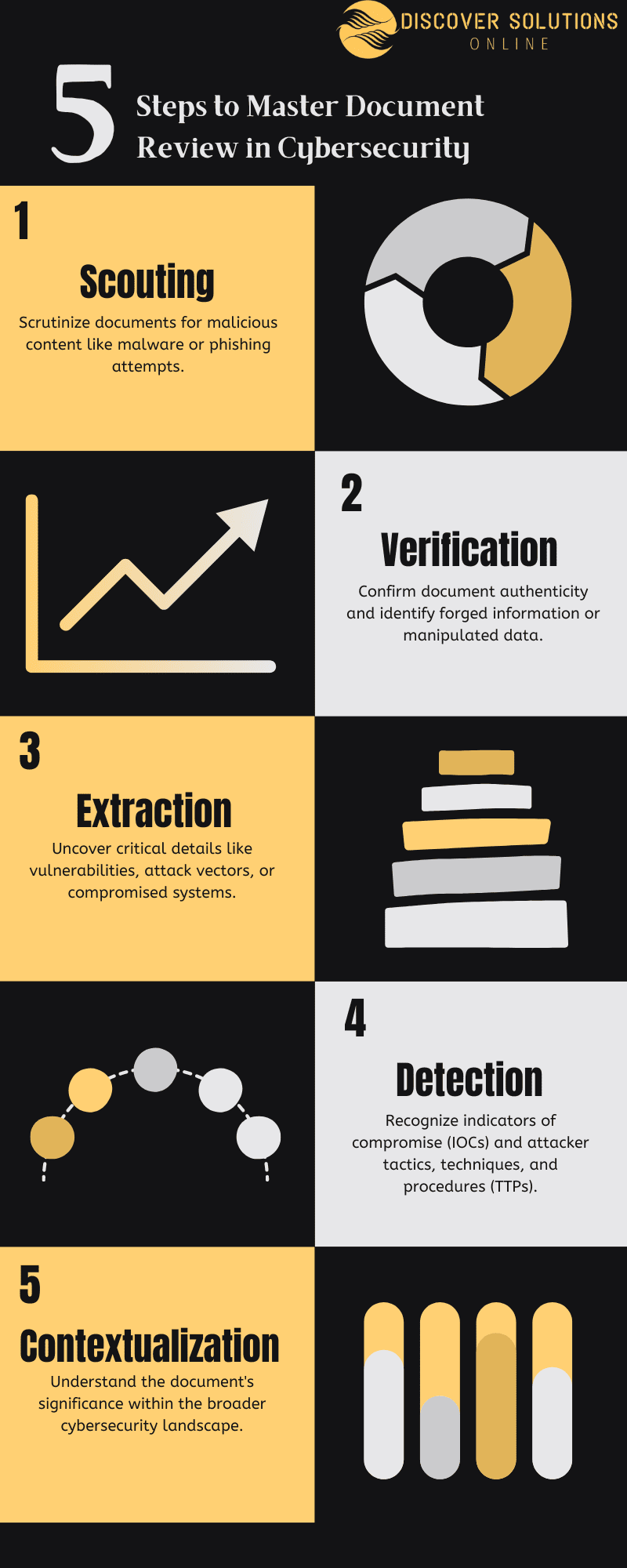Decoding document review in cybersecurity is a crucial process for identifying and protecting sensitive information. This information, which can range from personal details (PII) to financial records and proprietary business data, is essential for an organization’s operations and can be a target for cyberattacks. Through meticulous document review, organizations can effectively locate and classify such sensitive data, enabling them to implement targeted security measures and safeguard their most valuable assets. This comprehensive review process plays a pivotal role in mitigating cybersecurity risks and ensuring data integrity.
The Importance of Document Review in Cybersecurity
Document review in the cybersecurity realm involves the meticulous examination of various digital artifacts, logs, communication records, and any other relevant documents to uncover evidence of malicious activities or security breaches. It serves as a proactive measure to identify vulnerabilities, track potential threats, and fortify defenses against future attacks.
Understanding the Threat Landscape
Conducting a document review allows cybersecurity professionals to piece together the puzzle of an incident. By analyzing logs and communication records, they can trace the footsteps of malicious actors, understand the methods employed, and identify potential points of entry or compromise. This understanding is invaluable for strengthening cybersecurity measures and preventing similar incidents in the future.
Identifying Sensitive Data
Sensitive data lies at the heart of many cyber-attacks, making its protection a top priority. Document review plays a pivotal role in identifying and safeguarding this critical information. Whether it’s personally identifiable information (PII), financial records, or proprietary business data, a comprehensive review helps ensure that organizations can implement targeted security measures to safeguard their most valuable assets.
Legal Compliance and Investigations
In the aftermath of a cybersecurity incident, organizations often find themselves subject to legal scrutiny. Document review is essential for compliance purposes, ensuring that organizations adhere to relevant regulations and standards. It also facilitates the investigation process, providing the necessary evidence and documentation to support legal actions against malicious actors.

Techniques for Identifying Sensitive Information in Document Review
Document review is an indispensable component of cybersecurity strategies, particularly when it comes to identifying and safeguarding sensitive information. Whether it’s personally identifiable information (PII), financial records, or proprietary business data, a thorough examination of documents can reveal critical insights that inform targeted security measures. In this section, we delve into the techniques employed in document review to effectively identify sensitive information and mitigate potential security risks.
Keyword Matching
One of the most basic yet effective techniques in document review is keyword matching. By creating a list of keywords associated with sensitive information such as social security numbers, credit card numbers, or confidential project names, cybersecurity professionals can quickly scan documents for matches. Advanced algorithms can even account for variations in spelling or formatting to ensure comprehensive coverage.
Pattern Recognition
Beyond individual keywords, pattern recognition techniques can identify sequences or combinations of words that indicate sensitive information. For instance, patterns resembling email addresses, phone numbers, or account numbers can be flagged for further scrutiny. Machine learning algorithms can be trained to recognize these patterns with high accuracy, making them invaluable tools in document review processes.
Contextual Analysis
Understanding the context surrounding certain terms or phrases is crucial for accurately identifying sensitive information. Contextual analysis involves analyzing the entire document or segment of text to determine its relevance and potential risk. For example, the presence of words like “confidential,” “restricted,” or “proprietary” in proximity to other keywords may signal the presence of sensitive information.
Entity Recognition
Entity recognition technologies can automatically identify and classify entities mentioned in documents, including people, organizations, locations, and more. By recognizing named entities, cybersecurity professionals can pinpoint references to individuals or entities associated with sensitive data, enabling targeted protective measures. This technique is particularly useful in large-scale document repositories where manual review would be impractical.
Metadata Examination
Documents often contain hidden metadata that can reveal valuable information about their creation, modification history, and authorship. Metadata examination involves extracting and analyzing this metadata to uncover potential security risks. For example, metadata might reveal unauthorized access or alterations to documents, providing insights into potential data breaches or insider threats.
Document Clustering
Document clustering algorithms group similar documents together based on their content, making it easier to identify clusters containing sensitive information. By analyzing the characteristics of these clusters, cybersecurity professionals can identify common themes or topics associated with sensitive data. This technique not only expedites the review process but also facilitates targeted remediation efforts.
Natural Language Processing (NLP)
NLP techniques enable computers to understand and interpret human language, allowing for more nuanced analysis of documents. By applying NLP algorithms, cybersecurity professionals can extract meaning from unstructured text data, identify sentiment, and detect anomalies indicative of security breaches. NLP can also aid in summarizing large volumes of documents, making it easier to prioritize review efforts.
Data Masking and Redaction
In cases where sensitive information cannot be securely removed from documents, data masking and redaction techniques can be employed to conceal or obfuscate the information. This involves replacing sensitive data with placeholder characters or removing it entirely while preserving the document’s overall structure and readability. Automated redaction tools can streamline this process, ensuring compliance with privacy regulations and data protection standards.
Behavioral Analysis
Behavioral analysis techniques can detect suspicious patterns or anomalies in document access and usage patterns. By monitoring user behavior and interactions with documents, cybersecurity professionals can identify unusual activities that may indicate unauthorized access or data exfiltration attempts. Behavioral analysis complements traditional content-based techniques, providing a holistic approach to document security.
Collaborative Filtering
Collaborative filtering algorithms analyze user interactions and preferences to recommend relevant documents or flag potentially sensitive content. By leveraging collective intelligence, these algorithms can surface documents that are likely to contain sensitive information based on similar users’ behaviors and preferences. Collaborative filtering enhances the efficiency and accuracy of document review processes, enabling organizations to proactively protect their sensitive assets.
Manual Review Strategies in Document Review for Cybersecurity
Where the protection of sensitive information is paramount, document review stands as a vital process. It serves as the frontline defense, identifying and safeguarding critical data such as personally identifiable information (PII), financial records, or proprietary business data. Manual review strategies within this domain play a pivotal role in ensuring the integrity and security of organizational assets. In this segment, we delve into the intricacies of manual review strategies and their significance in the broader cybersecurity landscape.
Understanding Manual Review
Manual review involves the meticulous examination of documents, files, or data sets by human analysts. Unlike automated processes, manual review relies on human judgment, intuition, and expertise to identify nuances and potential security risks. While automation has its advantages in speed and scalability, manual review remains indispensable for its ability to handle complex, ambiguous, or context-dependent situations.
Importance of Manual Review in Cybersecurity
Contextual Understanding: One of the primary advantages of manual review is its ability to contextualize information. Human analysts can interpret data in light of organizational policies, industry regulations, and evolving cybersecurity threats. This contextual understanding enables them to discern subtle nuances and identify anomalous patterns that automated tools might overlook.
Adaptability and Flexibility
Cyber threats are dynamic and constantly evolving. Manual review allows organizations to adapt quickly to emerging threats by adjusting review criteria, focusing on specific risk areas, or conducting targeted investigations. This flexibility is invaluable in maintaining proactive security measures and staying ahead of potential breaches.
Quality Assurance
Human review serves as a quality assurance mechanism, ensuring the accuracy and reliability of security assessments. By scrutinizing documents with attention to detail, analysts can detect errors, inconsistencies, or discrepancies that could compromise data integrity or security protocols. This meticulous approach enhances overall cybersecurity posture and instills confidence in organizational defenses.
Complex Data Analysis
While automated tools excel in processing large volumes of structured data, they may struggle with unstructured or semi-structured data formats. Manual review bridges this gap by offering human cognitive capabilities for complex data analysis, including natural language understanding, pattern recognition, and contextual inference. This capability is particularly valuable in industries where data formats vary widely or contain nuanced information.
Best Practices for Manual Review
Establish Clear Review Guidelines
Provide analysts with clear guidelines, protocols, and criteria for document review. Clearly define the objectives, scope, and expected outcomes of the review process to ensure consistency and alignment with organizational goals.
Continuous Training and Skill Development
Invest in training programs to enhance the skills and expertise of manual review analysts. Stay abreast of evolving cybersecurity trends, emerging threats, and best practices in document review methodologies. Foster a culture of learning and knowledge sharing to empower analysts with the tools and insights needed to perform their roles effectively.
Collaborative Approach
Encourage collaboration and knowledge sharing among review teams. Foster open communication channels, facilitate peer reviews, and leverage collective expertise to tackle complex challenges and mitigate potential biases or blind spots.
Regular Audits and Feedback Loops
Regular Audits and Feedback Loops: Conduct regular audits of the manual review process to evaluate performance, identify areas for improvement, and address potential bottlenecks or inefficiencies. Solicit feedback from analysts, stakeholders, and end-users to refine review methodologies, optimize workflows, and enhance overall effectiveness.
Best Practices for Secure Document Handling in Cybersecurity
Document review plays a pivotal role in identifying and safeguarding critical information, be it personally identifiable information (PII), financial records, or proprietary business data. A comprehensive review process not only helps in identifying sensitive information but also enables organizations to implement targeted security measures to safeguard their most valuable assets. In this section, we’ll delve into the best practices for secure document handling in cybersecurity.
Establish Clear Document Handling Policies
Begin by establishing clear and comprehensive document handling policies within your organization. These policies should outline guidelines for creating, storing, accessing, and disposing of documents securely. Ensure that all employees are aware of these policies and provide regular training to reinforce the importance of secure document handling practices.
Implement Encryption Techniques
Utilize encryption techniques to safeguard sensitive documents both at rest and in transit. Encrypting documents ensures that even if they are intercepted or accessed by unauthorized parties, they remain unreadable and protected. Implement strong encryption algorithms and ensure that encryption keys are managed securely.
Adopt Role-Based Access Controls (RBAC)
Implement role-based access controls to restrict access to sensitive documents based on user roles and responsibilities. By granting access only to authorized individuals, organizations can minimize the risk of unauthorized disclosure or modification of sensitive information. Regularly review and update access permissions to align with organizational changes.
Deploy Document Classification Systems
Implement document classification systems to categorize documents based on their sensitivity level. This allows organizations to prioritize security measures based on the criticality of the information contained within the documents. Classify documents as public, internal, confidential, or restricted, and apply appropriate security controls accordingly.
Enforce Strong Password Policies
Enforce strong password policies to prevent unauthorized access to document repositories and systems. Require employees to use complex passwords and encourage regular password changes. Consider implementing multi-factor authentication (MFA) for an additional layer of security, especially when accessing sensitive documents remotely.
Regularly Audit Document Access and Usage
Conduct regular audits of document access and usage to identify any suspicious or unauthorized activities. Monitor access logs, track document modifications, and investigate any anomalies or deviations from normal behavior. By maintaining a vigilant stance, organizations can detect and mitigate potential security incidents promptly.
Secure Document Sharing Practices
Implement secure document sharing practices to ensure that sensitive information is shared only with authorized parties. Utilize secure file transfer protocols, such as SFTP or encrypted email, when sharing documents externally. For internal document sharing, deploy collaboration platforms with built-in security features to control access and permissions.
Enable Document Versioning and Tracking
Enable document versioning and tracking mechanisms to maintain a clear record of document revisions and updates. This not only facilitates collaboration but also helps in tracking changes made to sensitive documents over time. In the event of a security incident or compliance audit, having comprehensive version history can prove invaluable.
Secure Document Destruction Procedures
Establish secure document destruction procedures to ensure that sensitive information is properly disposed of when no longer needed. Implement shredding or secure deletion methods for physical and digital documents to prevent unauthorized retrieval or reconstruction. Regularly review and update document retention policies to align with regulatory requirements.
Provide Ongoing Security Awareness Training
Lastly, provide ongoing security awareness training to educate employees about the importance of secure document handling practices. Empower them to recognize potential security threats, such as phishing attempts or social engineering tactics, and emphasize their role in safeguarding sensitive information. Encourage a culture of vigilance and accountability across the organization.
Discover Solutions Online: Facilitating Seamless Document Review in Cybersecurity
When it comes to Document Review in the cybersecurity realm, Discover Solutions Online stands out as a reliable partner. We understand the intricacies of handling sensitive information and the importance of a meticulous review process.
Expertise in Legal Documentation
Our team of legal professionals brings a wealth of experience in handling diverse legal documents, making them adept at identifying and extracting relevant information during cybersecurity document reviews. Their expertise ensures that no crucial detail is overlooked, providing a comprehensive understanding of the incident at hand.
Tailored Solutions for Every Scenario
Understanding that each cybersecurity incident is unique, Discover Solutions Online offers tailored solutions to meet the specific needs of our clients. Whether it’s a data breach, a malware attack, or a network intrusion, our team adapts its approach to ensure a thorough document review that addresses the nuances of each situation.
In conclusion, document review is a cornerstone of effective cybersecurity, and Discover Solutions Online is dedicated to providing top-notch legal services to support organizations in their efforts to identify and protect sensitive data in the face of cyber threats.
Identifying and Protecting Sensitive Data
In the dynamic landscape of cybersecurity, document review plays a pivotal role in identifying and protecting sensitive data. As organizations navigate through an increasingly digital world, the need to safeguard confidential information becomes more critical than ever. In this section, we’ll explore key strategies for identifying and protecting sensitive data during the document review process, emphasizing the importance of thorough scrutiny and the role that Discover Solutions Online can play in enhancing this safeguarding endeavor.
Understanding the Scope of Sensitive Data
Before diving into document review, it’s essential to define what constitutes sensitive data within the cybersecurity realm. This can include personally identifiable information (PII), financial records, intellectual property, and any other information that, if compromised, could lead to severe consequences for individuals or the organization as a whole.
Thorough Document Categorization
Effective document review begins with a meticulous categorization of data. Classifying documents based on their sensitivity allows for a more targeted approach to protection. Automated tools may aid in the initial sorting, but human expertise is indispensable for nuanced understanding and accurate categorization.
Comprehensive Metadata Analysis
Metadata, often overlooked, holds a wealth of information about a document. During the review process, it’s crucial to analyze metadata to understand the document’s history, origin, and any modifications. This step not only aids in identifying sensitive data but also in assessing the potential risks associated with each document.
Implementing Robust Access Controls
Identifying sensitive data is only half the battle; protecting it requires the implementation of robust access controls. Limiting access to confidential information to only those who genuinely need it reduces the risk of unauthorized exposure. Regularly reviewing and updating access permissions is vital in maintaining a secure environment.
Discover Solutions Online’s Role in Strengthening Document Review
Discover Solutions Online recognizes the critical importance of meticulous document review in cybersecurity. Our skilled professionals are adept at conducting comprehensive document reviews, identifying and categorizing sensitive data with precision.
We understand that each organization has unique needs, and our tailored approach allows us to adapt to specific requirements, providing a customized and effective document review process.
Furthermore, our commitment to data security aligns with the highest standards. Discover Solutions Online emphasizes strict confidentiality protocols and employs encryption methods to safeguard client information throughout the entire document review journey.
In conclusion, identifying and protecting sensitive data during document review is an integral aspect of cybersecurity. By implementing thorough categorization, metadata analysis, access controls, and encryption measures, organizations can fortify their defenses against potential threats. Discover Solutions Online stands as a reliable partner in this endeavor, offering expert legal outsourcing services to enhance the effectiveness of your document review process and safeguard your most sensitive information.
Safeguarding Sensitive Data through Document Review
Cybersecurity is paramount to safeguarding sensitive information from potential threats and breaches. As organizations increasingly rely on digital platforms and data-driven processes, the need for robust document review in the cybersecurity realm becomes more critical than ever. This article explores the vital role of document review in identifying and protecting sensitive data, with a focus on ensuring data security and compliance.
Identifying and Classifying Sensitive Data
One of the primary objectives of document review in cybersecurity is the identification and classification of sensitive data. This involves scrutinizing documents for any information that could pose a security risk if compromised. Discover Solutions Online recognizes the significance of this step in the document review process and employs a meticulous approach to ensure that no stone is left unturned.
Ensuring Compliance with Regulatory Standards
In an era where data protection regulations are becoming increasingly stringent, compliance is non-negotiable. Organizations must adhere to various standards and regulations to avoid legal repercussions and maintain the trust of their stakeholders. Discover Solutions Online understands the complex web of regulatory frameworks and integrates compliance checks into its document review process, ensuring that all sensitive data is handled in accordance with applicable laws and standards.
Leveraging Technology for Enhanced Document Review
Our expert team leverages cutting-edge technologies and methodologies to enhance the efficiency and accuracy of the review process. Through a combination of advanced search algorithms and machine learning techniques, the team can quickly identify and categorize sensitive data, streamlining the overall cybersecurity document review.
Discover Solutions Online Advantage
With a team of experienced legal professionals, Discover Solutions Online goes beyond the surface, delving deep into documents to identify potential risks and vulnerabilities. By partnering with us, organizations can benefit from a proactive approach to cybersecurity, mitigating threats and ensuring the confidentiality of their sensitive data.
In conclusion, document review is a cornerstone in the cybersecurity realm, playing a pivotal role in identifying and protecting sensitive data. Discover Solutions Online, with its commitment to thorough and compliant document review processes, empowers organizations to navigate the complexities of the digital landscape securely. Through a combination of expertise and advanced technologies, Discover Solutions Online stands as a reliable partner in the ongoing battle against cyber threats.





